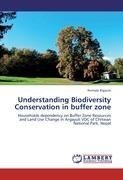
-
 Anglický jazyk
Anglický jazyk
Understanding Biodiversity Conservation in buffer zone
Autor: Nirmala Rajaure
Study included socio-economic characteristics, biodiversity assessment and land use of Argayuli Buffer Zone VDC of Chitwan National Park where information from 70 households based on random design, was gathered to tie up with vegetation ecology. The study... Viac o knihe
Na objednávku
45.36 €
bežná cena: 50.40 €
O knihe
Study included socio-economic characteristics, biodiversity assessment and land use of Argayuli Buffer Zone VDC of Chitwan National Park where information from 70 households based on random design, was gathered to tie up with vegetation ecology. The study forecast the socio-economic status of buffer zone households where deficit is mainly managed through remittance and wage labor. About 48.6% of the households faced food deficit and 15.7% did not have food even for a month, suggesting widespread poverty. Though forest area in Argayuli VDC increased by 12.71% between 1978 and 1992, buffer zone forest can only sustainably fulfill 32% of fuel wood and 0.9% of green fodder annually suggesting dependency on national forest and park. People extract 47.36% fuel wood and 16.03% fodder demand from buffer zone forest indicating over harvesting of resources. Rhinos were considered the most destructive animal in poverty stricken area as they damage crops all round the year, threatening their subsistence that made local people behave adversely on park and park management. Besides, invasive species, Mikania micrantha inside community forest indicated the wildlife habitat may get deteriorated.
- Vydavateľstvo: LAP LAMBERT Academic Publishing
- Rok vydania: 2011
- Formát: Paperback
- Rozmer: 220 x 150 mm
- Jazyk: Anglický jazyk
- ISBN: 9783845412122












